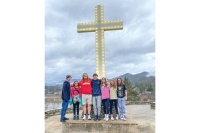Going for the green: Tribe debates future course for Sequoyah Golf Club
Despite a double-digit rise in revenue this year, the Sequoyah National Golf Club in Cherokee is at least five more years away from breaking even — let alone turning a profit.
“The cost of maintaining a golf course is astronomical,” said Ryan Ott, director of golf at the club.
To be successful, a golf course must have a quality staff, facilities and well-groomed fairway — all of which come with a price. Few golf courses are stand-alone entities like Sequoyah. Most are run as part of a larger business model, with a country club, restaurant, condos or real estate development underwriting the cost of the course.
“Golf courses aren’t self-sufficient,” Ott said. “Most golf courses are built around some sort of housing.”
Despite this, however, the Eastern Band of Cherokee Indians, which owns the course, is determined to make it work.
“Our goal is to make this a break-even or at better a profitable center,” said Michell Hicks, principal chief of the Eastern Band.
Related Items
The club needs to be more aggressive in its public relations and advertising initiatives, he said.
“We’ve got to make it work,” Hicks said.
The $9 million golf course was built nearly three years ago as an amenity for tribal members as well as an additional draw for visitors to Harrah’s Cherokee Casino. But, tribal leaders have grown weary of helping keep the golf course afloat.
Hicks and members of Tribal Council grilled Ott about the golf course’s budget for more than an hour at a tribal council meeting this month.
“This is dead weight expense to the tribe right now,” said Mike Parker, a council member from Wolftown.
Although Sequoyah’s revenue jumped 20 percent compared to the previous year, it is still in the red.
Tribal Council members agreed that the Eastern Band cannot continue to subsidize the golf course in the way that it has because it takes money away from other tribal programs.
The tribe will supplement the club’s budget with $1.2 million next year. Similar to how Harrah’s is operated, the tribe contracts with an outside management entity, Troon Golf, to run the golf course. Troon, which runs 220 golf courses worldwide, has three more years on its contract with the tribe.
Tribal council members questioned whether the budget for the golf course is too generous.
“I cannot support this budget right now due to fact that we’ve got all our tribal programs on cost containment,” said Tunney Crowe, a council member from Birdtown.
Crowe pointed to a particular line item for Sequoyah — a $30,000 budget for employee relations, which includes human resources expenses, travel and association dues — as an example. Other departments and organizations run by the tribe have little or no money in their employee relations line item, Crowe said.
Adam Wachacha, a tribal council member from Snowbird, said he agreed with Crowe and did not support the budget.
Tribal Council has become a “punching bag” for the golf course, he said, citing numerous complaints from the public about the money being pumped into the course.
“We get some positive, but we get a lot of negative out of it,” Wachacha said.
Kim Peone, the tribe’s chief finance officer, countered council’s budget concerns, saying the club has “bare-boned the budget” for next year. Though, she added, the budget could be trimmed more the following year.
Designing a destination
When the tribe ponied up $9 million to build the signature golf course three years ago, it was seen as an integral component in their long-range vision to become a resort destination. It complement a major expansion of Harrah’s Cherokee Casino, which is adding amenities like a spa, luxury suites and upscale dining.
Meanwhile, the golf course fit the tribe’s mission of improving the quality of life for tribal members, with a concerted push to increase recreation outlets. The tribe has built a movie theater, skate park, walking trails and children’s water park.
The golf club’s debt from the construction was paid off this month, Ott said. However, he would not say how large an operational deficit the course is running nor what its total budget is.
Several tribal council members verbalized a desire that Harrah’s and Sequoyah work together to attract visitors. In a perfect world, people would stay at a hotel on the reservation, shop at its stores, gamble at its casino and play a round of golf. Cherokee would be a destination for vacationers, not a brief excursion.
Because of its higher prices, the club has had trouble attracting players.
Memberships are currently $200 with a $35 green fee —meaning members must pay $35 each time they tee off. Non-members are charged between $35 and $59 to play at Sequoyah.
This year, the club had 87 members, and it wants to increase that number to 150 members next year. The 63 new members would amount to about $30,000 in additional revenue, Ott said. The goal for 2012 is another 20 percent increase in revenue, he said.
Parker said he had hoped to hear more about how exactly the golf course can become profitable and how it can work with other area attractions such as the casino to bring visitors to Cherokee.
“It could a very viable component to the gaming side of it going forward,” Parker said.
Although the course’s bottom line may be a negative drain on tribal coffers, it could have intangible benefits that are hard to quantity — namely whether the new amenity increases the reservation’s overall profits by attracting cliental who wouldn’t otherwise come to gamble at the casino or support other area businesses.
The club began offering stay-and-play packages in June and booked 144 hotel rooms this year through the program. That number does not account for people who rented a room through the hotel and decided to golf while in Cherokee.
Next year, the club wants to increase that number to 300 hotel room nights. Sequoyah will book stay-and-play packages starting in May. Golf courses’ peak season is March through October.
“That’s a huge thing for us going into 2012,” Ott said.
Caddying for the customer
The club is currently working on several projects aimed at putting more tees in the grass, but Ott said he was not ready to disclose his plans, which are part of a five-year plan aimed at getting the club to break even.
Like the rest of Cherokee, Ott hopes to cash in on the possible deal between the tribe and the state. The agreement would allow Harrah’s casino to offer live table games in addition to the digital gaming now available.
“That’s the player that plays a lot of golf,” Ott said.
One item that the casino has but the golf course lacks is alcohol. Although Sequoyah is not technically on the reservation, it must follow the reservation’s alcohol ban. The golf course is a tribal operation, therefore it must follow tribal law.
However, with the addition of a tribally run ABC store and a new alcohol referendum up for vote, that could soon change. If tribe members vote to allow alcohol to be sold on the reservation this coming April, officials at the golf course would look into obtaining a liquor license.
Alcohol would “make a dramatic difference in the guest experience,” Ott said, adding that other courses in Western North Carolina already offer such services.
“Guest satisfaction is what keeps people coming back,” he said. “Our goal is to get them back year after year after year.”
Most of the club’s business comes from word-of-mouth or as a result of its search engine marketing campaign. Sequoyah receives 700 to 800 clicks to their site per month through the campaign, Ott said.
One way to build up the course’s reputation is to appeal to the youth market, Ott said.
“Teaching our youth the game of golf is what’s going to help grow the golf course in the community,” Ott said, calling junior golf programs a “big, big” focus.
Currently, the course hosts a summer camp and leagues from the local high schools practice there.
One major marketing snafu is people having trouble finding the golf course. The course is located on U.S. 441 and is marked by a single sign, which is easily missed among the surrounding greenery.
But because of a Jackson County ordinance, their signage options are limited.
Ott said he often hears about people getting lost on their way to clubhouse and has worked with GPS companies for nearly three years, attempting to fix their misleading directions.
The club has also created a mobile application for Apple products and Android phones that helps visitors find their way. The app includes other helpful features including visuals of each hole and its characteristics. An upcoming version, yet to be released, will also have a voice over describing each hole and a pro tip to help golfers stay at or under par.
In addition to the course off U.S. 441, Sequoyah operates a Callaway golf store in Harrah’s casino, which also advertises the golf course’s existence to hotel guests and gamblers.
“That has been a big, big push for us,” Ott said.
People can also use their Harrah’s reward points to play at the golf course.









